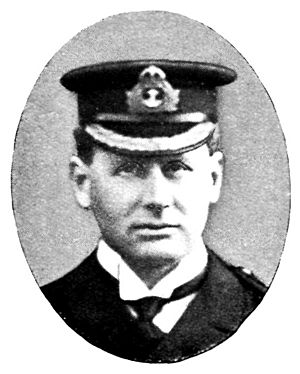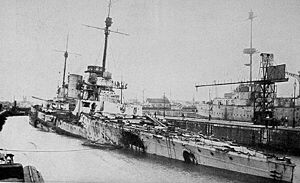Hugh Evan-Thomas facts for kids
Quick facts for kids
Hugh Evan-Thomas
|
|
|---|---|

H. Evan-Thomas
|
|
| Nickname(s) | Old Voice |
| Born | 27 October 1862 Gnoll, Neath, Glamorgan |
| Died | 30 August 1928 (aged 65) Cople, Bedfordshire |
| Allegiance | |
| Service/ |
|
| Years of service | 1877–1924 |
| Rank | Admiral |
| Commands held | Nore Command |
| Battles/wars | Battle of Jutland (31 May – 1 June 1916) |
| Awards | Knight Grand Cross of the Order of the Bath Member of the Royal Victorian Order KCMG |
| Relations | Charles Evan-Thomas (nephew) |
Admiral Sir Hugh Evan-Thomas (born 27 October 1862 – died 30 August 1928) was a brave officer in the Royal Navy from Britain. He was known for his leadership during World War I.
During the war, he led the 5th Battle Squadron of the Grand Fleet. His main ship was HMS Barham. He played an important part in the famous Battle of Jutland in 1916.
Contents
Early Life and Family
Hugh Evan-Thomas came from a family in Wales. They had owned land there for 200 years. His family also owned large estates like the Gnoll in Neath, Glamorgan. Even with these estates, his family had seven children and not a lot of extra money. Hugh had to rely on his navy salary to support himself.
Hugh Evan-Thomas was born to Charles Evan-Thomas. His father was an important local official called the High Sheriff of Brecknockshire in 1885. Hugh passed away in Cople, Bedfordshire, when he was 65 years old. A special service was held for him in a church in Wales. A year later, the Gnoll estate where he was born became a public park. A war memorial was also built there.
Admiral Jellicoe, a very important naval leader, spoke highly of Evan-Thomas. He said that Hugh was a "loyal and splendid supporter" during the Great War. Jellicoe added that Evan-Thomas led his ships "magnificently" and made them very efficient.
In 1877, when Hugh was just 15, he joined the navy as a cadet. He trained on the ship HMS Britannia. That same year, two royal princes, George Frederick and his older brother Albert Victor, also joined the ship. Their tutor, John Neale Dalton, liked Hugh and allowed him to become friends with the princes. Hugh left the Britannia in December 1877, but his friendship with the princes continued. Prince George even sent him a Christmas card!
In 1878, Hugh was assigned to HMS Swiftsure in the Mediterranean fleet. Around this time, his family changed their last name from Thomas to Evan-Thomas. His captain said he was a good and hardworking officer. Later, he moved to HMS Monarch. His new captain described him as a "very promising young officer."
Serving with Royalty
In 1879, Hugh was chosen to join HMS Bacchante. The crew on this ship was specially picked to be good role models for the two princes. The Bacchante went on three long trips, including a journey around the world. During one trip, the ship was near a war zone, which worried Queen Victoria about her grandsons. Luckily, the ship was not involved in any fighting.
A big storm off Western Australia damaged the ship's rudder. The crew had to use their bodies as makeshift sails to steer the ship to safety. Hugh was one of the few officers allowed to spend time with the princes. He often joined them on trips ashore for riding, shooting, and sightseeing. In Japan, they even met the Emperor! In 1882, Hugh left the ship after being promoted to sub-lieutenant.
Hugh then spent time at the Royal Naval College, Greenwich, for more training. Here, he became good friends with Lieutenant John Jellicoe. Jellicoe later became a very important leader in the British fleet during World War I. Hugh continued to write to the princes. In 1883, he was promoted to Lieutenant. Prince George even wrote to congratulate him.
Hugh served on HMS Sultan for a while. After that, he became a flag-lieutenant on HMS Bellerophon. He also served on HMS St Vincent and HMS Camperdown. In 1890, he moved to HMS Victoria. His commander was very impressed with him.
On January 14, 1892, Hugh was on duty when he received news that Prince Edward had died. He was responsible for lowering the ship's flags to half-mast. A few weeks later, Prince George asked for Hugh to be transferred to the royal yacht HMY Osborne. Prince George was given command of HMS Melampus and chose Hugh to be his first lieutenant. This was a big responsibility for Hugh.
In 1893, the Osborne sailed to Italy. Hugh often went ashore with the royal family. He had to make sure everything ran smoothly for them. His captain said he was a "zealous and hardworking officer."
Life in the Mediterranean Fleet
On June 22, 1893, a terrible accident happened. The flagship of the Mediterranean fleet, HMS Victoria, crashed into HMS Camperdown. The Victoria sank, and 358 lives were lost. Hugh was asked to join the new commander, Admiral Sir Michael Culme-Seymour, as his flag-lieutenant. Hugh was chosen because he was considered the best person for the job.
Admiral Culme-Seymour worked hard to make his fleet strong again. He held many training exercises. Hugh learned a lot about how to control a fleet using flag signals. At this time, ships communicated using thousands of flag combinations. This system was very detailed. Hugh became an expert in these signals.
Hugh sometimes got sick while in the Mediterranean. In 1894, he took leave to go back to England and marry Hilda Barnard. They got married on July 18, 1894. Later, they moved to Valletta on Malta, where the fleet was based. Hugh's time in the Mediterranean ended in December 1896. His commander praised him for his "great tact and judgement." On January 1, 1897, Hugh was promoted to commander.
Hugh then helped revise the navy's signal book. In 1898, he saw an early test of wireless radio by Guglielmo Marconi. Hugh wrote a report saying the experiment was a success and suggested trying it on warships. This was a very important step for naval communication.
In November 1900, Hugh got his first independent command: the cruiser HMS Pioneer. He was 38 years old. After two years, he was promoted to captain in 1902. He then became the flag captain for Vice-Admiral Lord Charles Beresford, commanding HMS Majestic and HMS Caesar. Beresford praised Hugh, saying he was "certain of a most brilliant career."
Important Roles in the Admiralty
In 1905, Hugh became captain of HMS Enchantress, a yacht used by the First Lord of the Admiralty (the government minister in charge of the navy). Soon after, he became the Naval Secretary to the First Lord. This was a time of big changes in the navy. Hugh worked well with important leaders like John Fisher, even though Fisher had disagreements with Hugh's former commander, Beresford.
In 1908, Hugh returned to sea to command HMS Bellerophon. This was a new type of powerful battleship called a dreadnought battleship. During a fleet exercise in 1909, his ship was praised for finding enemy cruisers. However, another time, his ship accidentally ran into six enemy battleships in the mist, ending their part in the exercise.
In 1910, HMS Bellerophon tested a new "director firing system." This system allowed all the main guns to be controlled from one high point on the ship. This helped ships shoot more accurately from far away. Hugh wasn't sure about the system at first, but it later became very important in naval battles.
In July 1910, Hugh accepted command of the Britannia Royal Naval College at Dartmouth. This was where young naval cadets, including the two princes Edward and Albert, trained. In 1911, measles spread through the college. The princes had to move to Hugh's home until the outbreak was over. Both princes got sick but recovered.
In July 1912, Hugh was promoted to Rear-Admiral. In December 1913, he became second in command of the first battle squadron of the Home fleet.
World War I and the Battle of Jutland
In October 1915, Hugh was given a very important job: commander of the 5th Battle Squadron. This squadron had five brand-new, powerful battleships called the Queen Elizabeth-class. These ships were very fast and had huge 15-inch guns. HMS Barham was Hugh's flagship. This was a very respected position.
Before the Battle of Jutland, Hugh's squadron was temporarily attached to the battlecruisers. These battlecruisers had different rules than the Grand Fleet. Unfortunately, Hugh did not get copies of their rules. This caused problems later during the battle.
On May 30, 1916, the British navy learned that the German fleet was planning to go to sea. The British ships set out to meet them. Hugh's squadron was positioned behind the main battlecruisers.
During the battle, the British ships had trouble with flag signals. Hugh's squadron couldn't read a signal to turn, so they kept going in the wrong direction for a while. This created a big gap between his ships and the main battlecruisers.
The German ships started firing first. Two British battlecruisers, Indefatigable and Queen Mary, were hit and exploded. Hugh's squadron finally got close enough to start firing. They chased the German ships, which were heading towards their main fleet.
When the British ships met the main German fleet, Hugh's squadron was ordered to turn around. Another signal error happened. The order to turn was not given clearly, and the ships turned one after another in the same spot. This made them easy targets for the German fleet.
Hugh's ships, being better armored, continued to fight well. Some of his ships were badly damaged. HMS Warspite had steering problems and ended up steaming in circles in the middle of the battle. This actually helped another damaged British ship, Warrior, escape. The German fleet eventually turned away and escaped.
After the Battle of Jutland, Admiral Jellicoe was replaced by Beatty as commander of the Grand Fleet. Hugh commented that their new chief would be "first rate." Beatty chose the Queen Elizabeth, one of Hugh's squadron's ships, as his new flagship.
In June 1917, King George V visited the fleet. He held a ceremony on the Queen Elizabeth to give awards to sailors who fought at Jutland. Hugh received his knighthood from the King during this ceremony.
On October 1, 1918, Hugh was replaced as commander of the 5th Battle Squadron. In 1921, he became the Commander-in-Chief, The Nore, a home port command. He received many awards from different countries. In 1922, he became High Sheriff of Glamorgan.
Legacy
Mount Evan-Thomas, a tall mountain in Alberta, Canada, is named in honor of Hugh Evan-Thomas.





